|
|
Your Details
|
|
Your Details
|
Reviewed By Andreas Zabczyk
Ancient Egyptian Gemstone JewelryThe first evidence of jewelry making in ancient Egypt dates back to 4000 BC. In ancient Egypt, both men and women had a strong affinity for jewelry, adorning themselves with a plethora of ornaments. Jewelry not only symbolized wealth and status but also provided protection against malevolent forces. This safeguard was believed to extend to both the living and the deceased, bringing prosperity in both the current life and the afterlife. 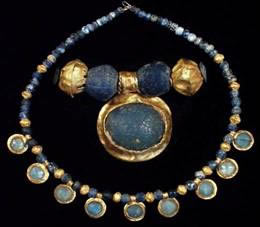 Ancient Egyptian Necklace
There was a variety of jewelry including amulets, necklaces, pendants, bracelets, rings, head jewelry, anklets, diadems, collars and insignia. Many of the ancient Egyptian methods for cutting gemstones have been lost, but the quality is still there today. Although the Egyptians had access to many precious gemstones, they preferred to use softer, semi-precious stones such carnelian, jasper, lapis lazuli, malachite, quartz and turquoise. The color of the jewelry and gemstones was very important to the Egyptians, since certain colors were thought to provide protection against evil and good luck. In many ancient cultures royalty was represented by the color blue, and this was especially true in ancient Egypt, making lapis lazuli one of the most prized of all gemstones. 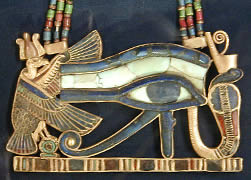 Lapis & Carnelian Pendant
Turquoise is another opaque gemstone that was favored by the Egyptians. The coloring is similar to that of the tropical sea and it was used to represent joy, cleanliness and pleasure. The infamous golden burial mask of King Tut was inlaid with turquoise, lapis lazuli and carnelian. Most of the raw materials that were used to make jewelry were found in, or near Egypt, but certain prized materials such as lapis lazuli were imported from as far away as Afghanistan. Queen Cleopatra's favorite gemstone was emerald, and she even gifted foreign dignities emeralds carved in her likeness. Emeralds were mined locally near the Red Sea. Egypt held the monopoly on emeralds till the 16th century. Today, an emerald in perfect condition is worth far more than a white diamond due to the rarity of the stone. Egyptians linked emeralds to fertility, immortality, rejuvenation and eternal spring. Today, a lady wearing an elegant emerald necklace or ring can feel just as much of a queen as Cleopatra. 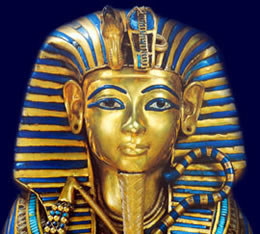 One of King Tut's Coffins
Not everyone could afford emerald or semi precious gems so, in order, to provide cheap materials for the lower social classes, Egyptian artisans invented the art of fake gemstones. Ancient artisans became so adept at crafting glass bead versions of precious stones that it was difficult to distinguish authentic emeralds, pearls and tiger's eye. For ancient Egyptians, the color of each gemstone had a different meaning. For example jewelry that was green was meant to symbolize fertility and the success of new crops, while a recently deceased person would wear a red-colored necklace on their throat to satisfy Isis's hunger for blood. The rings worn by men in ancient Egypt were not just ornamental, they were a necessary tool of administration. Official documents were not signed, but sealed, and therefore authenticated. The poor man's seal was a simple copper or silver ring while the rich man's seal was an elaborate jewel. The ring would be set with a precious stone engraved with the owner's emblem such as a scorpion, lion or a hawk. 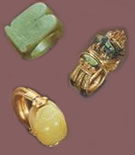 Egyptian Rings
The Egyptian scarab beetle was used as an amulet or a good luck charm by both the rich and the poor. A depiction of a scarab beetle was used in the making of various types of pendants, bracelets, rings and necklaces. Scarab jewelry was believed to hold strong magical and religious powers and the scarab was a symbol of rebirth. The name of the owner was inscribed on the flat base of the scarab to ensure that protection would be bestowed upon the wearer. Scarab pendants, bracelets, rings and necklaces were often made of precious or semi-precious jewels such as carnelian, lapis lazuli and turquoise. 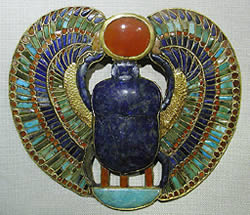 Tutanhkamun Lapis Scarab
Some fine early examples of scarab finger-rings discovered by archeologists were owned by Sithathoriunet, daughter of an ancient Egyptian king of the 12th dynasty. A treasure trove of jewelry was found at her burial site in El-Lahun. In each finger-ring the scarab's wings are inlaid with strips of turquoise, lapis lazuli and other gemstones, above its head is carnelian and its entire body and legs are lapis lazuli. Egyptian bracelets were produced in a variety of different types. Some bracelets were anklets and armlets that were plain gold rings, whilst wrist bracelets were made of small beads in gold, lapis lazuli, carnelian, and green feldspar, strung on gold wire.
Due to the religious beliefs of the ancient Egyptians, jewelry items were much needed by the deceased in the afterlife, and an abundance of jewelry was buried with the dead. In fact ancient Egyptians prepared themselves from early life to the day they died by collecting as much protective jewelry as possible to be buried with them. Immense treasures and jewelry were buried with the dead for use in the afterlife and this was the main reason why Egyptian mummies were so widely plundered. Apart from gold, lots of jewelry was found that was made from precious and semi precious stones. In 1901, during an excavation of the tomb of Djer, the second Pharaoh of Egypt's 1st Dynasty, four bracelets were found.
They were found still in place on the arm of a woman, whose body was wrapped in linen bandages and concealed in the wall of the tomb. They are made from gold, lapis lazuli, turquoise and amethyst. Many people know that purple is known to represent royalty, but they are not familiar with the fact that it goes back to the amethyst of ancient Egyptian sovereigns. We hope you've found this article interesting. Why not email us with your thoughts or any questions? We always like to hear from our customers. |
